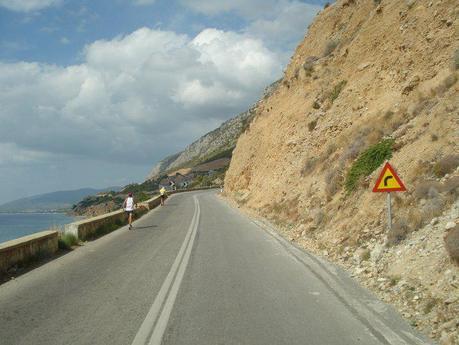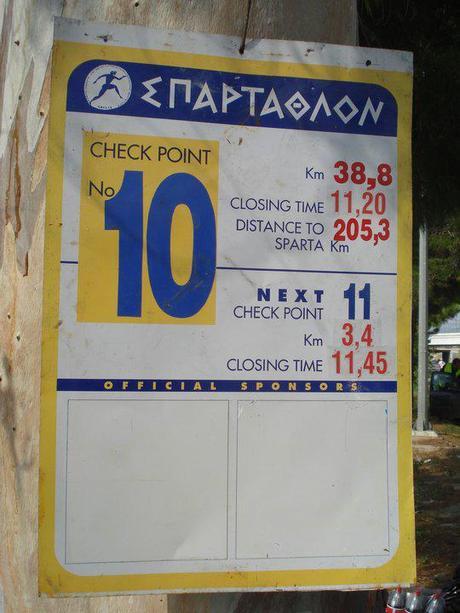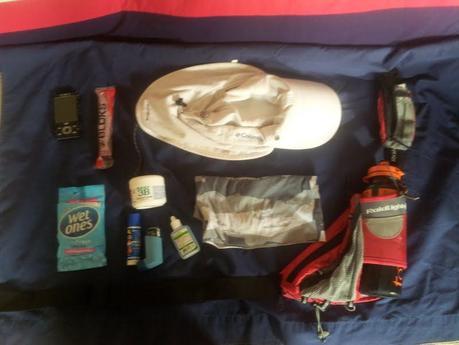This is an update of an article I wrote a while back giving last minute advice on the Spartathlon. I wrote last year's based on two finishes out of two starts. Last year I went out just to watch this amazing race and think I learned even more about how to tackle it.
There are other sources of info about slaying this beast out there and I have included some links here. Please let me know if there are any others to add.
This is more some thoughts for the race day. It’s not a “training guide”, I assume that everyone at the start line is capable of running 153 miles.
First and foremost the best ultra advice I can give comes straight from the Hitchikers Guide to the Galaxy. DON'T PANIC. This is one race where those who panic fail.
This is a very simple race, it’s just a lot of miles on road. It does not claim to be the longest, hottest, hilliest, highest, coldest, wettest or deadliest out there but based on lots of reports from ultra-runners who have done all the races making these claims the Spartathlon certainly ranks up there with the hardest races in the world.

The cut-off for the first marathon is 4.45. Unless you are planning on winning you really should not be more than an hour inside this time at this stage. The problem is you get here and say “shit – I am only half an hour inside the cut-off, I must now run like hell to get more time for the 50 mile cut-off”. This leads to many runners just burning out in the first 50 and having not a lot left for the small matter of the last 103 miles.
The cut-off for the 50 mile stage is 9.30, which itself is quite fast and beyond many people on it’s own. If the times were divided evenly for the whole 153 then this cut-off should be something like 11.45. I think the reason is to get people off the busy roads and into the countryside before it gets too late and dark. You don’t need to be way ahead of the cut-offs at this stage, there is plenty of time in the next 50 to chip away at them.
The first year I did this I got to the 50 in 7.37, the fastest 50 miles I have ever done. Though I felt quite good at the time I was made to pay for this speed later on as my body fell apart, particularly in the last 50. The next year I did it I got there in about 8.30, nearly an hour slower but I was in so much better shape physically that I ended up finishing over 2 hours quicker.
So in summary, don’t run like an idiot.
Anyway, I laboured the above quite a bit as I believe based on being in this race twice that what I have described is the single biggest reason of DNFing, not the cut-offs themselves but the panic they create. DON’T PANIC.
One more thing. Don’t obsess about your times from checkpoint to checkpoint. All of the 75 checkpoints have displays saying when it closes and this means that you can calculate easily how far you are ahead of the cull. It also means that you will be able to rate each section in terms of how much time you have gained or lost. My advice would be not to do this as it really messes with your head. I realize this is like saying “Don’t think about polar bears”. Just don’t look at your watch every time.
SOME GENERAL RACE STUFF
Ignore the signs
Try this. imagine the number 2837. Now add three to each of these digits and say out loud the new number (when it goes to 10 it resets to 0) - so 5160. Repeat this every 3 seconds. 8493. 1726. 4059. XXXX. XXXX.
How did you get on? Well done if you managed to stick with it for a while, it is quite difficult. But did you notice what happened to your body? You were probably not wearing your heart rate monitor at the time but your heart rate lept up by a few beats per minute, your pupils dialated, you were breathing in a bit more that usual, your skin temperature rose, you perhaps started to sweat and overall you got just a little bit stressed. It wasn't really a problem because you are just sat in front of a computer wondering whether there is anything better to read on the internet.
Now, imagine you did this exercise while your heart was already pounding, while your skin was warm, your body sweating and you were already a bit stessed? Say for example you were running a 153 mile race in the heat? This mental exercise would be a stupid thing to do voluntarily. Yet this is what you'll be doing every time you stop and look at all those numbers on those checkpoint signs. You'll look at the km completed, look at your watch, try to calculate how fast you have done the last 3.7km, you'll then try to exprapolate that into an overall pace, you'll probably get it wrong, you'll panic and want to run faster because you think that you are going to get timed out, you'll find it really hard to go faster because you are wasting heart beats performing useless calculations.
Instead I would apply a simple rule. If you can still see people around you then you are still in the race. It's not watertight but simple enough to not have to think about it.
The Heat
*Warning - I have just read and become a convert to many of the ideas in Tim Noakes' book "Waterlogged" regarding hydration*
I don't have a huge amount to say about the heat except that in recent years I think I was wrong in believing that drinking water/fluid no matter how cold cools your body down. It doesn't. Throwing cold water over your skin does, soaking your clothes does but putting it inside your body does not cool it down. Don't confuse thirst with being hot and bothered. If you are thirsty then drink, if you are hot then cover yourself with water or slow down. Don't respond to being hot by guzzling fluid when you are not thirsty.
There is not much shade in the race, a few sections with trees and some bridges. If you are getting too hot then walk the shady sections and under bridges.
Be Ruthless
You might have agreed to run with someone for the entire race, this is a dangerous commitment to make. I saw last year while spectating two instances of runners pairing up and one getting sick. This is a race where you can get unlucky and become sick and that would make your life very difficult. If you are running with someone who becomes ill or slows down for whatever reason you really have to be ruthless if you want to finish the race for yourself. You need to leave them behind. It sucks but I suggest having such an agreement before you start that ideally you'd like to run with each other but in the event of someone falling behind then you are going to leave them for their own sake.
The Race
First 50
Be careful at the start. From the Acropolis it is downhill on cobbles and in a crowd. You certainly do not want to twist an ankle with 152.9 miles to go, that would hurt a lot.
The first few miles are through the busy streets of Athens but the police do a fantastic job of stopping the traffic so that the runners can pass through. Most road crossings will have the police there to stop traffic and wave you across. The first two checkpoints are pretty far apart.
Once you are out of the center of Athens you are treated to some quite ugly industrial parks and refineries and such. As the day warms up this can get a bit suffocating. After about 40 miles you are running along the coast and this is lovely, a couple of inclines in there. The 2 miles before the first major checkpoint at Hellas is another busy grim road but after that it’s lovely.
I’d say don’t spend too long at Hellas Can though I always do. There are lots of places to sit, there are usually at least 30 runners and their supporters there hanging around eating and resting. You will find the atmosphere change immediately here, from busy roads to really quiet and windy paths through olive fields.
If you can stick with the Brazilian runners, their support teams are a very nice visual distraction : ) 
The second 50
From 80-115k are gently uphill so don’t worry too much about slowing down, remember that the cut-off you have just made for 50 was quite tight and now they ease up a bit. As the sun sets you’ll pass through some lovely little villages where the people really come out and support. I recommend eating the proper food they put on (rice, soup etc) the rest tends to be, dry biscuits and fruit.
There will be kids asking for autographs. Sign then it will make you feel better. Not all of them though there can be quite a lot. Maybe get a stamp or do what Wayne Rooney does and just put an “X”.
It gets dark at seven, exactly 12 hours after the start (it is this that allowed Heroditus to estimate that it took Phiddipides 36 hours to complete this, from sunrise to sunset the next day). It goes down quickly behind the mountains that will now surround you. Be ready with your lights and stuff as it gets very dark.
It can get windy and cold too (and rain is very common too). Bin Bags are very effective for keep the rain out and giving a little warmth while being disposable. Consider putting them in each of your drop bags as they were few and far between last year.
There is a section along a dirt path. If it rains this becomes quite hard but otherwise the path is very good.
Shortly before the mountain there are about 2 miles of slow slogging uphill. I find this is a perfect opportunity to walk, eat, drink coffee etc. Consider leaving some food in a drop bag in CP 46.
CP47 (MOUNTAIN BASE) is brilliant, particularly if you are British. This is run by a team of Brits who go crazy when they see a fellow countryman. There are beds where you can have a massage (or sleep but I would not recommend that).

This is one of most wonderful parts of any race I have ever done. It’s up there with the left turn on the canal or the McDonalds in Lone Pine or Washington Bridge. Take your time and enjoy.
It is a scramble to get up the thing but having pounded your legs on 100 miles of road it actually can feel like a break. It is so well lit up you can’t go wrong. It gets cold at the top though but I recommend just taking a minute to look behind you at what you have done. The villages are still lit up with the action of the race.
Be careful going down. I ruined myself the first year, it really hurt. The path down is quite easy but in the dark and with 100 miles in you it’s easy to trip over. Inevitably you might find that both up and down there is a lot of overtaking, you may pass people or they may pass you. Don’t think too much about this, the mountain goats will obviously fly up the hill faster but they might be slow on the road again. I always lose positions on the mountain (first year I lost about 40, second year I think just 2).
I always put a change of shoes in the drop bag after the mountain. 100 miles of smashing one pair on a road might remove all the air from them. I don't know really but have always felt pretty good putting on a fresh pair of shoes with 50 miles to go.
The Last 50ish
After the downhill things are generally up again. It’s similar to the second 50 except towards the end the road gets very busy. Try not to sit down especially now as it’s so hard to get back up again. At this stage you may start losing time on the cut-offs but try not to think about this too much if you are sufficiently ahead.
Not much more to say other than the finish is pretty special : )
Drop Bags and Carrying stuff
Most important thing to remember here is to do your own thing. First year I did this I only intended on having 5 drop bags but saw others putting 20 or more down. On seeing this I thought “I must be wrong then” and at the last minute changed my mind and had 20 drop bags. Come the race I hardly touched most of them and got confused as to where they were. The following year I only had 5 and that worked perfectly (apart from my own error of not putting the head lights early enough).
Do your own thing and don’t change it at the last minute just because others are doing differently. DON’T PANIC
I carried a bottle belt with small storage space last year which worked well for me. Some reports say it’s unnecessary to carry such things but it is a matter of personal preference. You don’t need to carry much water as there is lots along the way but I did like having something to carry my phone, electrolytes and lube in. I’d say about half the runners there will carry something like this with them.
Try to clearly mark your drop bags. The people on the stations are generally very good at spotting you and handing you your bag. Also be prepared not to get stuff back. Again they are very good at returning stuff generally but sometimes labels come off or things fall out. Everything that is picked up in the race will go back to Athens where you collect your things and if it not marked it will be in a miscellaneous pile.
I don’t really have much to say on what to put in the bags. If you have specific food requirements (all the checkpoints have crisps, dried fruit, sweets, toast, yoghurt tea and coffee - Some of the bigger ones have great hot food which you should take advantage of) then you may need lots of drop bags. You will obviously need lights at night, also another layer for the night as it does get cold. Waterproofs depending on the forecast (or bin bags). I have put another pair of shoes in just after the mountain both years I have done it and that worked well. Socks are a good idea too especially if it will rain.
I would consider putting a bin bag in each of your drop bags in case it rains, just in case you did not have a waterporrof or are seperated from it.
Spare hats/shades/suncream etc for the next day. I forgot a hat last year but luckily there was no sun. In the event of sun I was going to trade my head torch for a hat with some kid but it never came to that.
Though it will be dark the road is usually good quality and you will not need a super powered head torch. I'll be taking something lightweight or perhaps a hand torch instead. No need to strap 1kg of battery on your head.

The Finish
I don't need to tell you that this is the most special finish of any race I have ever done. I don't need to tell you how it feels when you stride through the streets of Sparta to cheering crowds and awestruck kids. I don't need to mention the respect gained by those who line the streets, the police who escort you to the statue as the pain of 153 miles of labor dissolves into a singularity at the foot of an ancient warrior. I don't need to tell you how much you too will feel like a warrior as you are cheered by your fellow brothers and sisters in arms and as you make your own way to the finish.
I don't need to tell you how it feels to have completed years worth of work under the respectful gaze of one of history's finest warriors and retracing the steps of one of history's finest athletes. I don't need to tell you just how good it feels to taste the metallic foot of Leonidas and celebrate your victory with the people of Sparta and the 300 athletes of this amazing race. I don't need to tell you just how awesome it makes you feel when you find the energy for one last climb and mount those steps to his feet.
I don't need to tell you just how much it means to finish this race. When you get there, you'll know.
Enjoy :)
Some race reports
Rune Larsson "How to run the Spartathlon"
John Foden "Time spent at refreshment stations"
John Tyszkiewicz
Brits Newsletter 2010
Brits Newsletter 2009
Robin Harvie Telegraph Article
Mark Cockbain's race reports are on his website
